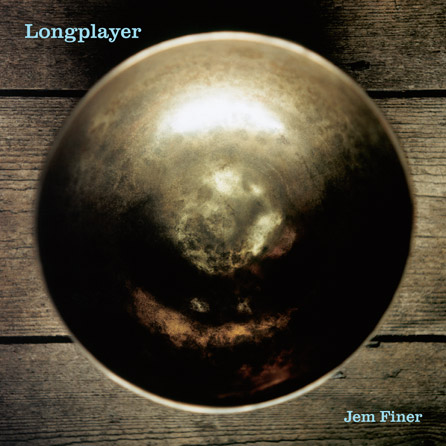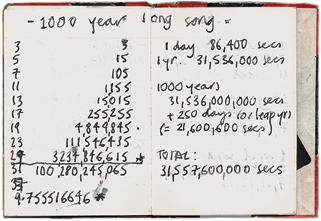LONGPLAYER
Blogpost: an experience a unique fragment of a durational piece lasting 1000 year
Longplayer is a thousand year long cyclical composition for singing bowls which has been playing since 31 December 1999. The work, conceived and composed by Jem Finer can be heard at listening posts worldwide and via a live-stream and an iOS app. Longplayer had its successful debut in the Netherlands for the 2018 edition of Holland Festival. Now, for the 2020 edition – in light of unprecedented circumstances – the festival has decided to bring the piece back. From 11 to 21 June, this long-durational piece will once again play in the tower of the historic Lloyd Hotel. Every 30 minutes, one person at a time may climb up to the tower for an intimate encounter with a unique fragment of this elemental music that repeats but once a millennium. In uncertain times, this installation is a slow space for the listener to pause and recalibrate, while connecting with a community of listeners across centuries.
Longplayer is a thousand year long cyclical composition for singing bowls which has been playing since 31 December 1999. The work, conceived and composed by Jem Finer can be heard at listening posts worldwide and via a live-stream and an iOS app. Longplayer had its successful debut in the Netherlands for the 2018 edition of Holland Festival. Now, for the 2020 edition – in light of unprecedented circumstances – the festival has decided to bring the piece back. From 11 to 21 June, this long-durational piece will once again play in the tower of the historic Lloyd Hotel. Every 30 minutes, one person at a time may climb up to the tower for an intimate encounter with a unique fragment of this elemental music that repeats but once a millennium. In uncertain times, this installation is a slow space for the listener to pause and recalibrate, while connecting with a community of listeners across centuries.


Website: http://longplayer.org
In this episode, artist and composer Jem Finer discusses his 1000-year-long music composition, Longplayer. He talks about his artistic process, ruminates on the value of the 'unknowable,’ and shares thoughts on what AI could learn from the artwork's unique approach to both temporality and community.
Background information
A note from the composer
‘Longplayer is a piece of music I wrote at the end of the last century. It's long(ish), being a looping composition that repeats once every 1000 years. But really the music isn't the whole point.
It grew out of a lifelong curiosity about time and its dimensions, traced back to temporally vertiginous childhood encounters with starlight and ancient stones and the ebb and flow of time before clocks. For me it's more about creating a space to dream one's way into long flows of time, an experiment in ‘making’ time. But everyone has their own take on it - which is as it should be.’ - Jem Finer
Longplayer is composed in such a way that its music changes from day to day and ‒ though it is beyond the reach of any one person’s experience ‒ from century to century. It works in a way somewhat akin to a system of planets, which are aligned only once every thousand years, and whose orbits meanwhile move in and out of phase with each other. In a similar way, Longplayer is predetermined from beginning to end ‒ its movements are calculable, but are occurring on a scale so vast as to be all but unknowable.
Longplayer’s composition uses a minimum amount of information and material to create the maximum amount of variety, in terms of both sound and form. While it is a system-based composition, it is made out of very expansive and resonant musical material, which in itself is not systematic’ sounding. This material (the ‘source music’) is played on singing bowls, which possess a simple but harmonically rich sound, and a quality which is at once both physical and ethereal.
Implicit in Longplayerʼs composition is the ability for it to be performed by any technology, a necessity given its duration and the futureʼs unpredictability. Until now it’s been performed mostly by computers, while more recently an iOS app was released on the iTunes store introducing a new way to listen to Longplayer, anywhere, at any time and without the need for a data connection. This 'Amsterdam' version is played through an iPad and a 360° speaker.
However, Longplayer was created with a full awareness of the inevitable obsolescence of this technology, and is not in itself bound to the computer or any other technological form. Although computer devices are a cheap and accurate way in which Longplayer can play, it is important ‒ in order to legislate for its survival ‒ that a medium outside the digital realm be found. To this end, one objective has been to research alternative methods of performance, including mechanical, non-electrical and human-operated versions. Among these is a graphical score for six players and 234 singing bowls. The first performance based on this score took place over 1,000 minutes on 12 ‒ 13 September, 2009, at the Roundhouse, London.
During the Holland Festival, Longplayer can be experienced by one person at a time in the tower of the Lloyd Hotel, a place that is normally inaccessible to visitors.
Biography
Jem Finer is a UK-based musician and composer. Since studying computer science, he has worked in a variety of fields, including photography, film, music and installation.
His 1000 year long musical composition, Longplayer, represents a convergence of many of his concerns, particularly those relating to systems, long-durational processes and extremes of scale in both time and space. Among his other works is Score For a Hole In the Ground, a permanent, selfsustaining musical installation in a forest in Kent which relies only on gravity and the elements to be audible. He spent two years as artist in residence in the astrophysics department of Oxford University, making a number of works including two sculptural observatories, Landscope and The Centre of the Universe. During a year-long residency at the ICIA (University of Bath), he developed Mobile Sinfonia, an indeterminate musical composition scored for mobile phones and propagated globally through the free distribution of ringtones. Recent work, focusing on his interest in long-term sustainability and the reconfiguring of older technologies, includes Spiegelei, a 360-degree spherical camera obscura and Supercomputer, a sculptural machine composing minimal musical scores which opened in Cambridge in June 2014. He has written and recorded a number of film soundtracks.
A note from the composer
‘Longplayer is a piece of music I wrote at the end of the last century. It's long(ish), being a looping composition that repeats once every 1000 years. But really the music isn't the whole point.
It grew out of a lifelong curiosity about time and its dimensions, traced back to temporally vertiginous childhood encounters with starlight and ancient stones and the ebb and flow of time before clocks. For me it's more about creating a space to dream one's way into long flows of time, an experiment in ‘making’ time. But everyone has their own take on it - which is as it should be.’ - Jem Finer
Longplayer is composed in such a way that its music changes from day to day and ‒ though it is beyond the reach of any one person’s experience ‒ from century to century. It works in a way somewhat akin to a system of planets, which are aligned only once every thousand years, and whose orbits meanwhile move in and out of phase with each other. In a similar way, Longplayer is predetermined from beginning to end ‒ its movements are calculable, but are occurring on a scale so vast as to be all but unknowable.
Longplayer’s composition uses a minimum amount of information and material to create the maximum amount of variety, in terms of both sound and form. While it is a system-based composition, it is made out of very expansive and resonant musical material, which in itself is not systematic’ sounding. This material (the ‘source music’) is played on singing bowls, which possess a simple but harmonically rich sound, and a quality which is at once both physical and ethereal.
Implicit in Longplayerʼs composition is the ability for it to be performed by any technology, a necessity given its duration and the futureʼs unpredictability. Until now it’s been performed mostly by computers, while more recently an iOS app was released on the iTunes store introducing a new way to listen to Longplayer, anywhere, at any time and without the need for a data connection. This 'Amsterdam' version is played through an iPad and a 360° speaker.
However, Longplayer was created with a full awareness of the inevitable obsolescence of this technology, and is not in itself bound to the computer or any other technological form. Although computer devices are a cheap and accurate way in which Longplayer can play, it is important ‒ in order to legislate for its survival ‒ that a medium outside the digital realm be found. To this end, one objective has been to research alternative methods of performance, including mechanical, non-electrical and human-operated versions. Among these is a graphical score for six players and 234 singing bowls. The first performance based on this score took place over 1,000 minutes on 12 ‒ 13 September, 2009, at the Roundhouse, London.
During the Holland Festival, Longplayer can be experienced by one person at a time in the tower of the Lloyd Hotel, a place that is normally inaccessible to visitors.
Biography
Jem Finer is a UK-based musician and composer. Since studying computer science, he has worked in a variety of fields, including photography, film, music and installation.
His 1000 year long musical composition, Longplayer, represents a convergence of many of his concerns, particularly those relating to systems, long-durational processes and extremes of scale in both time and space. Among his other works is Score For a Hole In the Ground, a permanent, selfsustaining musical installation in a forest in Kent which relies only on gravity and the elements to be audible. He spent two years as artist in residence in the astrophysics department of Oxford University, making a number of works including two sculptural observatories, Landscope and The Centre of the Universe. During a year-long residency at the ICIA (University of Bath), he developed Mobile Sinfonia, an indeterminate musical composition scored for mobile phones and propagated globally through the free distribution of ringtones. Recent work, focusing on his interest in long-term sustainability and the reconfiguring of older technologies, includes Spiegelei, a 360-degree spherical camera obscura and Supercomputer, a sculptural machine composing minimal musical scores which opened in Cambridge in June 2014. He has written and recorded a number of film soundtracks.